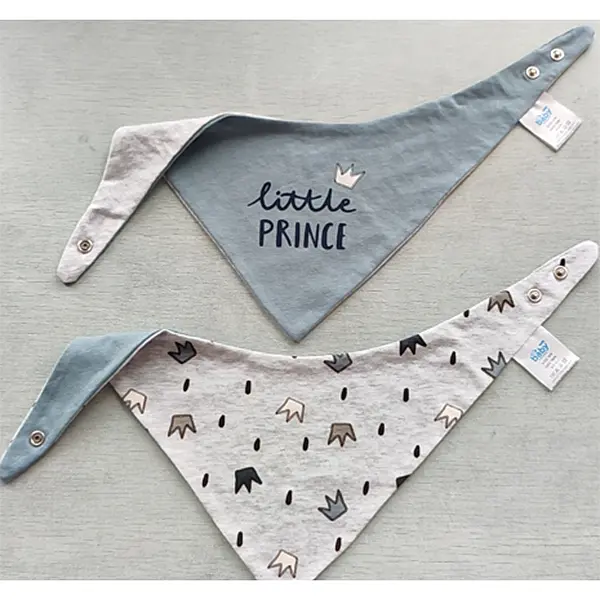Organic Bandana Bibs: 100% Organic Cotton—Softer, Safer?
Organic bandana bibs: what’s real, what’s hype, and what to buy in 2025
Parents are savvy now. They want cute, durable, safe—and yes, greener—baby gear that doesn’t fall apart after three washes. That’s where organic bandana bibs come into the conversation. I’ve handled more bib samples than I’d like to admit, and the ones that consistently punch above their weight use tightly knit interlock cotton, solid snaps, and low-impact dyes. The set I’m looking at today—“100% cotton 2pcs per set baby bandana bibs made of interlock fabric,” produced in Shijiazhuang, Hebei—ticks several of those boxes. To be honest, it’s the practical bits that win the day.

Industry trend check: eco, but make it usable
The market is moving toward safer chemistry (think OEKO-TEX and GOTS), better absorbency, and longer service life. Many customers say they’ll pay a bit more if bibs actually keep outfits dry during the teething deluge. Interlock cotton—especially in GOTS-certified form when specified—has become the quiet favorite because it’s soft, dense, and resists twisting. If you’re sourcing, ask vendors about certification options; real-world inventories vary.

Core specs (approximate, because fabric lots vary)
| Fabric | Interlock 100% cotton; organic option on request (GOTS-eligible) |
| Weight | ≈180–220 gsm (real-world use may vary) |
| Layers | 2-layer construction for absorbency + drape |
| Closure | Nickel-free snaps; snap pull test per ASTM D4846 |
| Sizing | 0–24 months adjustable, bandana silhouette |
| Wash life | ≈100 home-laundry cycles before notable pilling/fade |
Test notes: AATCC 61 (colorfastness to laundering) 4–5; AATCC 8 (crocking) 4; AATCC 135 (dimensional change) within ±5% after 3 washes—lab conditions; household results vary.

How they’re made (short version)
- Materials: combed cotton yarn; organic yarn available upon request (supplier must declare GOTS scope).
- Knitting & dyeing: interlock knit; low-AZO, REACH-compliant reactive dyes; OEKO-TEX Standard 100 class I achievable.
- Cut & sew: contoured bandana panels, overlock + topstitch; snaps applied with calibrated press.
- Testing: needle detection, CPSIA lead checks, EN 1811 nickel release on snaps, seam strength ASTM D1683.
- Service life: designed for daily drool duty; many parents use organic bandana bibs through the whole teething arc.

Use cases (and little real-world quirks)
Teething days, stroller naps, daycare (label the back), baby-led weaning, travel outfits, first-photos—these bibs pull double duty as accessory and drool shield. Parents tell me the curved drop catches drips before they hit the onesie—which, honestly, is the whole point. If you want the eco angle, choose organic bandana bibs with traceable cotton and ask for documented certifications.
Vendor snapshot: who does what
| Vendor | Certs/Options | Lead Time & MOQ | Customization |
|---|---|---|---|
| STHometextile (Hebei, China) | OEKO-TEX achievable; GOTS cotton on request; CPSIA/REACH compliance | ≈25–35 days; MOQ around 500 sets | Prints, embroidery, private label, retail-ready packs |
| Marketplace Vendor (generic) | Limited docs; “organic” claims vary | Ship-from-stock; MOQ low | Mostly off-the-shelf |
| Boutique Maker (EU/US) | Often GOTS-certified lines | 4–8 weeks; small batch | High-touch, seasonal drops |

Customization ideas
- GOTS-certified organic interlock in core colors; low-MOQ digital prints.
- Nickel-free snap colors, double-snap adjustability, brand-patch placement.
- Retail packaging: recycled card wraps, QR care cards, barcode/UPC.
Mini case study (retail)
A Nordic boutique switched to interlock-based organic bandana bibs with nickel-free snaps and low-impact dyes. They reported ≈20% fewer returns for “soaks through” and stronger Instagram engagement (parents love the scarf look). It’s anecdotal, sure, but it matches what I’ve seen: fabric density + smart patterning beats gimmicks.

Final notes on compliance
For export, ask for: OEKO-TEX Standard 100 (Class I), CPSIA lead and phthalate compliance, EN 1811 nickel release on snaps, AATCC colorfastness and absorption (AATCC 79) data, and, if applicable, GOTS transaction certificates. It seems fussy; however, that paper trail protects you—and baby cheeks.
Origin: Room 1106-1108 Zhongyuan Building, No.368 North Youyi Street, Shijiazhuang, Hebei, China.
Authoritative sources
- Global Organic Textile Standard (GOTS), Version 7.0 – global-standard.org
- OEKO-TEX Standard 100, Product Class I – oeko-tex.com
- CPSIA/16 CFR (Lead, Phthalates, Children’s Products) – cpsc.gov
- AATCC Test Methods 8, 61, 79, 135 – aatcc.org
- EN 1811: Nickel release test (jewellery/snaps) – standards.iteh.ai or national standards bodies
-
OEM Rectangle Table Cloth: Custom Quality & Sustainable Solutions for Global BrandsNewsNov.24,2025
-
OEM Adult Bedding Set – Customized Quality Bedding Solutions for Healthcare, Hospitality & ReliefNewsNov.24,2025
-
OEM Summer Baby Garments – Quality, Comfort & Global SolutionsNewsNov.23,2025
-
OEM Solid Color Polyester Table Cloth – Durable, Customizable & Sustainable Textile SolutionsNewsNov.23,2025
-
OEM Baby Towels: Quality Manufacturing for Global Baby Care BrandsNewsNov.23,2025
-
OEM Woven Cotton 7pcs Crib Bedding Sets – Safe, Sustainable & Customized Baby Bedding SolutionsNewsNov.22,2025
- Product Categories
- • Hospital Used Fire Retardant Bedding
- • Hotel Textiles
- • Airline Textiles
- • Hometextiles
- • Infant Cloth
- Quick Links
- • Home
- • Products
- • About us
- • News
- • Contact
- Contact Us
-
Tel: +8631187701449
-
Fax: +86 311 8770 1444
-
E-mail: sale@hometex-suntex.com




